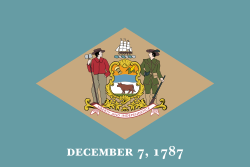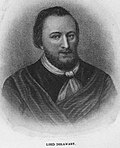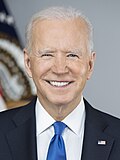Portal:Delaware
The Delaware Portal Delaware (/ˈdɛləwɛər/ ⓘ DEL-ə-wair) is a state in the Mid-Atlantic and South Atlantic regions of the United States. It borders Maryland to its south and west, Pennsylvania to its north, New Jersey to its northeast, and the Atlantic Ocean to its east. The state's name derives from the adjacent Delaware Bay, which in turn was named after Thomas West, 3rd Baron De La Warr, an English nobleman and the Colony of Virginia's first colonial-era governor. Delaware occupies the northeastern portion of the Delmarva Peninsula, and some islands and territory within the Delaware River. It is the second-smallest and sixth-least populous state, but also the sixth-most densely populated. Delaware's most populous city is Wilmington, and the state's capital is Dover, the second-most populous city in Delaware. The state is divided into three counties, the fewest number of counties of any of the 50 U.S. states; from north to south, the three counties are: New Castle County, Kent County, and Sussex County. The southern two counties, Kent and Sussex, have historically been predominantly agrarian economies. New Castle is more urbanized and is considered part of the Delaware Valley metropolitan statistical area that surrounds Philadelphia. Delaware is considered part of the Southern United States by the U.S. Census Bureau, but the state's geography, culture, and history are a hybrid of the Mid-Atlantic and Northeastern regions of the country. Before the Delaware coastline was explored and developed by Europeans in the 17th century, the state was inhabited by several Native American tribes, including the Lenape in the north and Nanticoke in the south. The state was first colonized by Dutch traders at Zwaanendael, near present-day Lewes, Delaware, in 1631. Delaware was one of the Thirteen Colonies that participated in the American Revolution against Great Britain, which established the United States as an independent nation. On December 7, 1787, Delaware was the first state to ratify the Constitution of the United States, earning it the nickname "The First State". (Full article...) Entries here consist of Good and Featured articles, which meet a core set of high editorial standards.
Oliver Evans (September 13, 1755 – April 15, 1819) was an American inventor, engineer, and businessman born in rural Delaware and later rooted commercially in Philadelphia. He was one of the first Americans to build steam engines and an advocate of high-pressure steam (as opposed to low-pressure steam). A pioneer in the fields of automation, materials handling and steam power, Evans was one of the most prolific and influential inventors in the early years of the United States. He left behind a long series of accomplishments, most notably designing and building the first fully automated industrial process, the first high-pressure steam engine, first vapor compression refrigeration and the first (albeit crude) amphibious vehicle and American automobile. Born in Newport, Delaware, Evans received little formal education and in his mid-teens was apprenticed to a wheelwright. Going into business with his brothers, he worked for over a decade designing, building and perfecting an automated mill with devices such as bucket chains and conveyor belts. In doing so Evans designed a continuous process of manufacturing that required no human labor. This novel concept would prove critical to the Industrial Revolution and the development of mass production. Later in life Evans turned his attention to steam power and built the first high-pressure steam engine in the United States in 1801, developing his design independently of Richard Trevithick, who built the first in the world a year earlier. Evans was a driving force in the development and adoption of high-pressure steam engines in the United States. Evans dreamed of building a steam-powered wagon and eventually constructing and running one in 1805. Known as the Oruktor Amphibolos, it was the first automobile in the country and the world's first amphibious vehicle, although it was too primitive to be a success as either. (Full article...) Selected article -This is a list of broadcast television stations that are licensed in the U.S. state of Delaware. Note: Delaware is served by four TV markets: Philadelphia (DMA #4), Salisbury/Dover (DMA #144), Baltimore (DMA #28), and Washington DC (DMA #9). See Template:Philly TV, Template:Salisbury TV, and Template:Baltimore TV, and Template:Washington TV for details. (Full article...) General images -The following are images from various Delaware-related articles on Wikipedia.
Did you know -
TopicsEntries here consist of Good articles, which meet a core set of high editorial standards.
Delaware Route 141 (DE 141) is a state highway that serves as a western bypass of Wilmington, Delaware. Its southern terminus is at DE 9 and DE 273 in New Castle and its northern terminus is an interchange with U.S. Route 202 (US 202) and DE 261 near Fairfax. The route heads north from DE 9 and DE 273 on four-lane divided Basin Road, becoming concurrent with US 202 at an interchange with US 13/US 40 in Wilmington Manor, and passes to the east of Wilmington Airport. The highway becomes a freeway and reaches an interchange with Interstate 95 (I-95), at which point US 202 splits from DE 141. The DE 141 freeway continues north through Newport to Prices Corner. Here, the freeway segment ends and DE 141 continues northeast as a surface road, with another brief freeway segment in Greenville. The route heads east across the Brandywine Creek on the Tyler-McConnell Bridge and continues to US 202 and DE 261. What is now DE 141 between New Castle and Newport was originally designated as part of DE 41 in the 1930s. DE 141 was designated as a surface bypass of Wilmington between New Castle and US 202 north of Wilmington in the 1950s, running concurrent with DE 41 south of Newport. DE 41 was removed from DE 141 by 1971. In the 1960s, DE 141 was proposed to be upgraded to a freeway. Construction on the freeway segments between Newport and Prices Corner and in Greenville began in the 1970s and was completed around 1980. In the 1990s, several improvements were planned for DE 141 north of Prices Corner, including grade separation at Rockland Road completed in 1997 and relocation of the northern terminus to its current location at an interchange with US 202 and DE 261 finished in 2007. (Full article...) Largest cities
CategoriesNew articlesThis list was generated from these rules. Questions and feedback are always welcome! The search is being run daily with the most recent ~14 days of results. Note: Some articles may not be relevant to this project.
Rules | Match log | Results page (for watching) | Last updated: 2025-06-25 20:41 (UTC) Note: The list display can now be customized by each user. See List display personalization for details.
Related portalsWikiProjects | ||||||||||||||||||||||||||||||||||||||||||||||||||||||
Associated Wikimedia
The following Wikimedia Foundation sister projects provide more on this subject:
-
Commons
Free media repository -
Wikibooks
Free textbooks and manuals -
Wikidata
Free knowledge base -
Wikinews
Free-content news -
Wikiquote
Collection of quotations -
Wikisource
Free-content library -
Wikiversity
Free learning tools -
Wikivoyage
Free travel guide -
Wiktionary
Dictionary and thesaurus








































